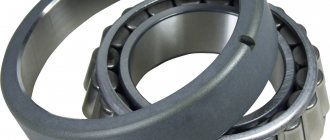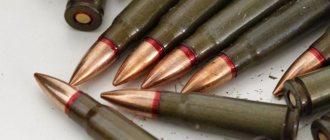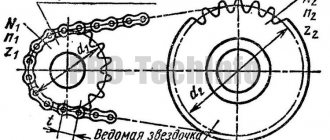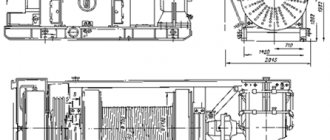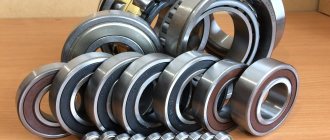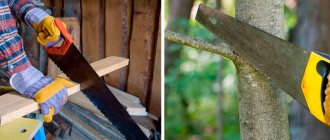The functionality of bearings is very wide. They are indispensable for ensuring reliable fixation, easy rotation or rolling, and reducing friction between two parts of the structure. The simple invention is one of the leading in the industry and is used everywhere. The performance and wear resistance of the machine largely depends on its quality. The variety of such assemblies is as great as their purpose. What is a bearing, what types exist and their classification according to their main characteristics, we will tell you in this article and show photographs.
What is a support
At its core, the part is the basis of the assembly unit. Its main function is to provide reliable support and support a certain moving part of the structure. How rigid such fixation will be depends on the device, material and many other factors.
Fixing the position in space allows for rotational movements and rolling with minimal resistance. This way the load is transferred from the moving part of the unit to others, maintaining wear resistance.
What are the types and types of bearings?
All assemblies can be classified according to their operating principle. Two main groups are devices that provide rocking and sliding. They are the ones most often used in mechanical engineering. The first can be represented by ball and roller devices.
Magnetic structures deserve special attention. The principle of their operation is different from the others, and they are used less often. In addition, due to their functional features, they must be accompanied by spare units.
Bearings are parts that help to obtain maximum efficiency from a machine, maintaining its performance without special repairs and maintenance.
Sliding supports
This group of parts allows you to slide freely when two contacting surfaces rub against each other. In this case, various lubricants are used - oils, water, chemicals, graphite and some gases. Structurally, such devices can be either integral or collapsible. Manufactured complete with bushing and connecting part.
Devices by rolling type
Such units are made in the form of two rings, bodies that provide a rocking effect, and a separator. They are manufactured in accordance with established standards, which allows them to be used in most cars, complex equipment and aircraft.
Ball bearings
Functionally, they are part of a group of node parts that operate on the rolling principle. Ball bodies are located on the surface of the outer rings of the parts. During operation, they create a small friction moment, which means they practically do not limit the rotation speed.
Roller bearings
They are part of the rolling group, but they are based on balls replaced by rollers. This allows them to withstand much greater loads. This performance is highly valued in the design of industrial machines and railway construction.
Magnetic supports
They work on the principle of levitation of attraction, ensuring complete non-contact of two adjacent parts. They can be used in aggressive environments, but are not yet as common as the types already listed. If you do not back up such a design with another, more traditional one, you can lose the entire car overnight.
Plain bearings
The main task of such parts is to ensure free friction between two mating sections. They can be used for both moving and fixed surfaces, which significantly increases the functionality of the application.
Types of sliding support units
This type of node part can be detachable or integral. The first consists of two liners installed in the half-holes of the base and cover. They may have a thick or thin wall relative to the outer diameter. The thickness is determined by the material used. For example, thin-walled ones are most often made of light low-carbon steel. The one-piece design involves a special assembly, in which a hole is drilled in the part into which a metal sleeve is pressed.
Varieties
The most common classification is based on the ability to absorb load in direction. In this case, devices are divided into 3 groups:
- • Radial – accepting perpendicular load from the axis.
- • Persistent – take on the entire load.
- • Radial-thrust – combine the properties of both.
There are several other options for separating nodes, but they are rather secondary.
Sliding bearing standards
The quality of workmanship of parts, the material used in the work and other production conditions are described in the Interstate ISO standard and GOST. The first one complies with international requirements valid in 165 countries of the world. The second is internal to the Russian Federation. All components presented undergo mandatory certification for compliance with the stated rules.
Plain bearing lubrication
This type is designed to provide free friction between two parts of the structure. For normal operation, one of 4 types of lubricants is used:
- • Liquid – various synthetic and mineral oil fluids for metal supports or water for non-metallic ones.
- • Plastic – made from base oil and thickener.
- • Solid – used in dry and boundary contact conditions. The materials most often chosen are graphite and molybdenum disulfide.
- • Gaseous – required when the structure operates under light load, but in hot conditions and at high speeds.
Advantages and disadvantages
Among the advantages are their high reliability when operating at high speed and their small size. As for the disadvantages, we note the need to constantly adjust the amount of lubricant, reduced efficiency and production from expensive materials.
Where are the devices used?
The scope of application of the devices is wide. Quite often they are used in high-speed equipment, steam and turbine units, in equipment for navigation systems and other precision instruments.
What is the difference between rolling bearings and plain bearings
In rolling bearings, rolling friction plays a dominant role, because The sliding friction between the cage and the rolling elements is usually small. Therefore, in rolling bearings, compared to plain bearings, there are significantly lower energy losses, as well as less mechanical wear.
The widespread use of rolling bearings is due to a number of their advantages compared to plain bearings: a lower moment of resistance to rotation, especially at the beginning of movement, as well as at low and medium speeds; greater load-bearing capacity per unit width of the bearing; complete interchangeability; ease of operation; less consumption of lubricants and non-ferrous metals; lower requirements for materials and heat treatment of shafts.
Rolling bearings
These nodal supports consist of two rings, but in addition to them, at the base there are always bodies that provide rocking and a separator. On the inner surface there are gutters that act as tracks. In rare cases, the separator may be absent, but then the level of resistance becomes higher.
Purpose
The main purpose of the devices is to serve as a stop for rotating parts of mechanisms. This is why they are more popular than slip knots. They are used in electrical machines and other structures where it is necessary to ensure wear resistance and long-term operation without lubrication.
Classification
Such parts can be divided according to several criteria, but the most common is the division according to the shape of the bodies and the acceptance of the load. The first group includes the previously mentioned ball and roller joint bearings. The second is similar to the division of sliding bearings by type of load.
Specifications
To select a particular device, you need to take into account several basic parameters. The most important are:
- • Overall dimensions established by the ISO standard.
- • Basic and complete designation, including an alphanumeric code indicating type, size and design.
- • Tolerances corresponding to classes.
- • Clearance, the total distance that one ring can move relative to another.
It offers to select the necessary part in accordance with all the characteristics. Our range includes a wide variety of bearings suitable for any mechanism.
Advantages and disadvantages
The main advantages are: low cost and mass production. If necessary, they can be easily replaced, which means installation and maintenance of the machines will become more convenient. Lubricants are used in small quantities, which allows you to avoid spending a lot of time on caring for mechanisms.
The disadvantages include:
- • Excessive sensitivity to vibration and shock loads.
- • Excessive heat and risk of destruction at high speeds.
- • Large radial dimensions.
- • Noise during operation.
Despite significant shortcomings, today they are the most popular all over the world.
Sliding: performance characteristics, advantages and disadvantages
Their design is different from rolling because in fact the two main parts (rings) do not roll on rollers, but slide against each other. The result is an increased area of friction, which consequently makes this force much greater. This is the main disadvantage that is attached to the product. If there is not enough lubricant, the metal will heat up, which can lead to failure.
Let's consider the advantages and disadvantages of the product.
Pros:
- At high rotation speeds they are very reliable, so they are used for turbines, aircraft construction and other important areas. This is ensured by the fact that the rolling body (ball) cannot jump out of the system at high speeds. In fact, this is a very primitive design, and the simpler it is, the fewer malfunctions can occur.
- The large area of the contacting surface leads to the fact that vibrations have little effect on it. This is also ensured by a dense layer of oil. This layer makes any shocks and vibration interference virtually unnoticeable.
- Small radial dimensions.
- It fits perfectly with the crankshaft, attaches to its journal and transmits torque.
There are also disadvantages:
- It loses in the classification of bearings by type of friction, because the mechanism rubs a lot, especially during start-up or low speeds. The metal heats up, its qualities are lost, and it may begin to crack or wear off.
- Wear is higher than that of the rolling unit, replacement is required more often.
- To function, the lubricant must be constantly replenished. This can be either automatic or manual.
Performance characteristics and structure
The inner sleeve, that is, a ring of smaller diameter, is usually created from a material with anti-friction properties. They have a low coefficient of friction, which partially eliminates the problem of all sliding mechanisms. The body is made of steel. It fits tightly onto the bushing. The small gap between them is intended to allow lubricant to flow there. The system assumes automatic feeding. The layer of this liquid is determined depending on pressure, temperature and actual flow.
Based on the type of sliding bearings and their application, the degree of friction can be determined:
- dry;
- borderline;
- hydrodynamic;
- gas-dynamic.
The first ones are most susceptible to rapid wear. It should also be taken into account that during a number of actions, for example, when starting or turning off, during slow rotation, all products belong to the second type, that is, they are at their maximum capabilities.
The durability of the unit is affected not only by operating conditions, but also by the nature of the lubricant used. Its functions are as follows:
- cooling, because when moving, heat is generated, and if there is excess heat, all nearby metal parts can be damaged;
- removal of friction force;
- protection of the part from external influences - not only dust particles and other contaminants, but also moisture can have a negative impact;
- rust prevention.
Another classification is based on the types of thrust sliding bearings based on the lubricant used. It can be dry, classic wet, gas or plastic. The most innovative development is the use of porous metal. This material has pores. It is as if impregnated with a dry substance, which changes its state of aggregation when heated. From the first movements, when the structure heats up, liquid begins to ooze out of small holes in the metal casing or in the bushing. After work, cooling occurs, and at the same time the lubricant returns to a powdery state.
Let's look at the product image:
But the proposed structure with a powder that changes its properties when heated is rather an exception to the rule. This is a difficult device that requires the use of expensive materials. Two other subspecies are considered classics. Types of plain bearings and their purpose, application, depending on the supply of lubricant:
- hydrostatic - it is necessary to maintain the liquid level from the outside, the mechanism receives a request for a low amount of liquid, this is implemented by other structures;
- hydrodynamic - more modern and original, their distinctive feature is that they themselves control the pressure as they rotate, when it becomes lower than it should be, the pump automatically fires, the container supplied from the outside begins to compress, transferring the required amount of lubricant.
And the last classification is the definition of design features. The body can rotate around different bushings. Bearings can be:
- Spherical. The sphere inside has significant deviations from the plane, so skew during movement is allowed. But the effectiveness will be confirmed only at low speeds. If you are tall, you definitely need strong support.
- Persistent. They only support axial loads.
- Linear. This type of bearing is installed in fans and other systems where classic circular rotation is required.
Now let's look at less general product classifications.
Ball bearing
This type of part uses balls that move freely along tracks as the body that provides rocking. Used for rotating structures that do not require strong friction between two moving parts.
Description
The unit consists of 2 rings made of steel. Together they form a kind of “bed” for ball bodies. In this case, the inner part of the device is fixed on the shaft, and the outer part is fixed on the support. Despite their simplicity of design, they are widely used in industry.
Varieties
What types of bearings with ball bodies there are can be guessed based on the general classification. Like most rolling parts, they are divided into: radial, thrust and with 4-point contact. The peculiarity of the latter is the ability to perceive load in two axis directions or simultaneous combined and axial load on one side.
Application
Different types are used in electric motors and various household appliances, in woodworking machines, in medical equipment, machine spindles and pumps. Ball bearings with 4-point contact are widely used in gearboxes.
Bearings with split races
To carry increased axial and radial-axial loads, bearings with an outer (Fig. 757, a) or, less commonly, internal (type b) race that is detachable in the equatorial plane are used. The connector allows you to increase the number of balls and deepen the running grooves.
With a purely radial load, three contact points are formed in bearings of this type - two on a split race and one on a whole race (hence their conventional name “three-contact” bearings). Correct rolling of balls simultaneously on three surfaces is, of course, impossible. The balls, which are braked by two-point contact with a detachable race, slide along the entire race, so three-contact bearings are used to carry an axial or radial load while simultaneously acting as an axial load. The axial load presses the balls against only one surface (see c), on the other side the balls move away from the surface of the treadmill, and the result is a two-contact bearing.
The contact angle β depends on the ratio of radial and axial load. With a purely axial load in completed structures β = 20–30°.
Detachable clips are usually tightened with fastening nuts, and the mutual centering of the clips occurs along the seating surface.
Bearings designed to carry purely axial loads are installed in housings with radial clearance. In this case, bearings with half-clips are used, tightly connected using a sleeve rolled at the ends (type d).
Roller bearings and their varieties
In their structure, these supports are similar to the previous type, but instead of balls, a body shaped like a roller is used here. This way the device can take on a heavier load.
Description
The design is designed in such a way that it shows resistance to radial pressure, but at the same time the speed of the roller along the track is in no way inferior to ball bearings. The only thing you should pay attention to is the axial load. To make the device more resistant to it, the rolling element is replaced with a conical one.
Kinds
This type is classified according to the body used. Separately distinguished:
- • Cylindrical.
- • Conical.
- • Needle-shaped.
- • Spherical.
Application
Roller bearings are often used in pumps, high-power gearboxes, the railway industry and the automotive industry. All types of roller bearings are presented in pictures on the website mirpl.ru.
Bearings with integral seals
The industry produces several types of deep groove ball bearings with built-in seals.
Single-sided (Fig. 758, a, b) and double-sided (views c-f) protective washers protect the bearings from the penetration of dirt; In indoor installations they serve to protect bearings from excess lubrication.
To seal bearings in end units, washers pressed with elastomers (types g, h) or felt seals (types i, j) are used.
Disposable lubricant bearings, into the internal cavity of which a measured amount of grease is placed when leaving the factory, are sealed with washers (types g, h) or double-sided felt seals (types l-m).
Magnetic support units
Unlike others, this device works on the principle of magnetic levitation. This ensures complete non-contact between the two parts of the structure.
Description
The elements are made in such a way that the shaft floats without contacting other surfaces. To ensure reliable operation, a large number of sensors are provided to coordinate all movements.
Varieties
There are two groups: active and passive. The first composition includes the bearing itself and the electronic system. The work of the second group is based on the presence of permanent magnets. They are less stable than in the case of an electronic control system, and therefore are used much less frequently.
Application
Such devices can be used in gas centrifuges, turbomolecular pumps, in various electromagnetic suspensions, in cryogenic technology, in vacuum devices and other complex mechanisms.
Advantages and disadvantages
As advantages, we highlight the wear resistance of parts and the possibility of their use in an aggressive environment, including in space. The disadvantages are manifested in the instability of the magnetic field, due to which traditional rolling or sliding devices are additionally built into the mechanism.
Lubrication procedure
According to information, there are several methods for lubricating bearing units using different materials. All lubricants are divided into two large groups - liquid and plastic materials, depending on consistency and composition.
Lubrication of rolling bearings using liquid materials involves the use of different methods:
- the product is immersed in a bath filled with oil, or the spray method is used; — under the influence of centrifugal forces; — drip treatment; — use of the “oil fog” effect.
The use of plastic materials implies filling the entire internal space. The sealed model with a contact seal on both sides and a large amount (reserve) of lubricant has a long service life. Such products do not require frequent maintenance, since the amount of lubricant is designed for the entire service life.
Other types
Let's consider several more types of nodal supports, differing in some functional features.
Tapered bearings
This is a type of roller, but the body here is made in the form of a cone and is installed on the track at an angle. They cope well with both radial and axial loads.
Self-aligning double row
They differ from others in their low friction, which makes them possible to operate at the highest speeds. Installed on a conical or cylindrical shaft journal.
Needle type
Here, a thin and long roller acts as a rolling body. The elements look more compact, but at the same time provide greater performance and reliability, and are economical to use.
Thrust ball bearings
The main purpose is the perception of axial loads. It belongs to the group of ball joints, so its appearance completely corresponds to them.
Spherical
Provide low friction. The design simultaneously includes two rows of rollers arranged symmetrically.
Heat resistant
Designed to work in hot conditions. They are distinguished by reliability and ease of operation.
Floating Nodal Support
Allows the shaft to move linearly. Bears only radial load. Easily adjustable and easy to operate.
Speed devices
Provides normal rolling at high speeds. They are distinguished by excellent quality and wear resistance.
Spindle
Has good load capacity. Often used in fans, powerful pumps and machine tools, as it works well at high speeds.
High precision
They have high performance characteristics, due to which they are often used in aircraft construction, astronautics and the military industry.
Closed
Equipped with seals that close open space. This allows for increased wear resistance in difficult conditions.
Flange bearings
The built-in flange increases the reliability of the fastening so that the part can withstand heavy loads.
Supporting
Perceive gravity along the axis of rotation. The scope of application is very limited, therefore it is less common than other options.
Linear Motion Devices
They have high performance qualities with minimal friction.
Radial bearings
The main types of radial rolling bearings are given in table. 36.
Single-row radial ball bearings (Table 36, ex. 1, 2) are designed to carry predominantly radial loads, but can simultaneously bear significant axial loads.
In bearings of this type, the balls roll in running grooves profiled by circular arcs with a radius equal to ~1.03 of the radius of the ball. The balls are enclosed in stamped sheet steel or massive separators that prevent friction between the balls and ensure a uniform distance between them. Bearings according to sketch 1 are assembled by displacing the inner race relative to the outer one and inserting the balls into the resulting crescent-shaped gap. In design 2, axial grooves are provided for inserting balls, which makes it possible to slightly increase the number of balls. Bearings of this type have increased radial load-bearing capacity. It is not recommended to use them to absorb axial loads directed towards the grooves.
The axial stiffness of ball bearings is low. The axial movement of the inner race relative to the outer one under high load reaches several tenths of a millimeter. The rigidity of paired installations can be increased by preloading the bearings.
Due to point contact, single row ball bearings have the lowest coefficient of friction among all bearings and are best suited for high rotation speeds.
Double-row radial ball bearings (3, 4) have increased load-bearing capacity, but are more sensitive to distortions.
Double-row spherical ball bearings (5, 6), which are self-aligning, are used in installations where elastic deformations of the shaft or displacement of the axis of one bearing relative to the axis of another are possible.
The reduction in radial load-bearing capacity due to the shape of the outer race tread, which is unfavorable for the contact strength, is compensated by the presence of two rows of balls. The shape of the treadmill with spherical bearings does not allow them to bear significant axial loads. Their axial rigidity is low.
Angular contact ball bearings (7, designed to absorb radial and axial forces simultaneously.
designed to absorb radial and axial forces simultaneously.
The shape of the outer race race allows the number of balls to be increased, which increases the load-bearing capacity of the bearing. Split angular contact bearings (7) allow easy removal of the outer race; in one-piece (8) bearings, the outer race is fixed on the balls by a shallow lip of the raceway. The latter design is more convenient for mounting the bearing in the unit.
Bearings designed for light axial loads have a contact angle β = 12°; for bearings for high axial loads β = 26–40°.
A single installation of angular contact bearings is used only with a constant axial load in the direction (for example, on vertical shafts). In most cases, a pair installation is used, closed by tightening the clips (external or internal).
Double angular contact bearings (9, 10) are produced with a preset gap (a), selected during tightening.
Radial contact bearings in a paired installation with interference provide virtually backlash-free centering and axial fixation of the shaft.
The sometimes used one-piece double-acting angular contact bearings (11, 12) do not have this advantage.
Radial roller bearings (13-15) are designed to carry high radial loads in the absence of axial loads. The increased load-bearing capacity of roller bearings (1.5-2 times greater than ball bearings of the same size) is due to the linear contact between the rollers and the treadmills, as well as the increased number of rollers (which are installed in the cages without difficulty).
One of the bearing races, usually the inner one (13), less often the outer one (14), is made with shoulders that guide the rollers as they move along the treadmills. The second clip is made smooth.
Bearings of this type allow a certain freedom of axial movement of one race relative to the other; they are often used as floating supports.
When installing, both clips must be fixed in the axial direction.
Bearings with shoulders on both races (15) can carry small axial loads; they are used to fix shafts.
Bearings are produced with detachable collars (16, 17). Design according to esc. 18 is not currently used due to its large axial dimensions.
Roller bearings with long rollers (19) are characterized by increased load-bearing capacity and smaller radial dimensions. The direction of the rollers when moving along treadmills is worse than in bearings with short rollers, so sometimes they use a multi-row installation of short rollers in a common cage (20) or use double-row roller bearings (21).
Bearings with twisted cylindrical rollers (22) are characterized by slightly increased elasticity in the radial direction. Their load-bearing capacity is significantly less than that of bearings with massive rollers.
For installation on crankshafts, bearings of this type are made with internal races that are split in the meridional plane and connected in a dovetail. These bearings are not widely used.
Needle bearings with rollers of small diameter and long length (23, 24) are used with constrained radial dimensions to carry increased radial loads at low rotation speeds.
Cylindrical spherical bearings (25), in which the ends of the rollers are made in a sphere, can, along with radial loads, absorb quite significant axial loads. The condition of pure rolling at the ends of the rollers in these bearings is not met.
Double-row self-aligning roller bearings with barrel rollers (26) compare favorably with spherical ball bearings with increased radial and axial load-bearing capacity. The condition of pure rolling in these bearings is not fully met.
Tapered roller bearings (27, 28) are used to support high radial and axial loads.
The cone angle of the outer treadmill in standard bearings is α = 20–30°. Their axial rigidity is low; the application of axial force Roc causes high loads on the rollers (N = Roc/sin α/2), as a result of which the rotation speed of these bearings is limited; they are sensitive to constriction. In bearings designed to bear increased axial loads, the angle α is increased to 60°. In a single installation, tapered roller bearings are used only as thrust bearings (mainly on vertical shafts); They are usually installed in pairs. The closure is carried out by installing both bearings mirror one in relation to the other, with the tightening of paired (external or internal) races, ensuring backlash-free centering and axial fixation of the shaft.
The industry produces double (29, 30) and multi-row (31) large-sized tapered roller bearings designed to carry particularly high loads.
